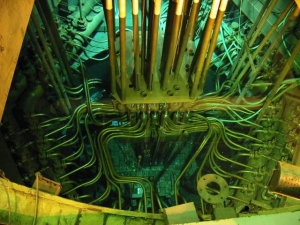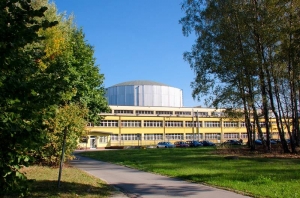40 years of the MARIA research reactor
16-12-2014
40 years is not much for a nuclear reactor. MARIA, the sole reactor in Poland is a research reactor operated in NCBJ Świerk near Warsaw primarily for physical research and to train staff for nuclear industry and radiation protection needs . It does not produce electricity but it does produce radiopharmaceuticals, special materials/radioactive sources for industry, environment protection and healthcare.
MARIA, the largest nuclear reactor in Świerk history and currently the sole nuclear reactor in Poland reached for the first time its critical state (i.e. a state in which all conditions of a self-sustaining nuclear chain reaction are met) on December 17, 1974. That day is taken as MARIA’s birthday. Currently MARIA’s power amounts to 30 MW. The reactor was planned as a supporting facility for the then to-be-developed nuclear power plant in Żarnowiec. Soon after the Żarnowiec project had been abandoned, MARIA found new applications.
„Our reactor is a good illustration of the fact that nuclear power programmes may stimulate development of not only the power industry itself, but can help to boom various sectors of national economy.” – points out Professor Grzegorz Wrochna, NCBJ Director General – „Our project to irradiate uranium targets has eventually positioned us among the globally largest suppliers of radiopharmaceuticals for nuclear medicine. Just one day of MARIA operation means supplies sufficient to treat about one hundred thousand patients”.
To-day MARIA is primarily a source of intense fluxes of neutrons. Neutrons are electrically neutral particles of very interesting properties, usually strongly bound within nuclei. They are subject to all four known physical interactions (strong, electromagnetic, weak, gravitational). Free neutrons may easily interact with nuclei since they do not need to overcome Coulomb barrier as charged particles (protons, electrons etc.) do. High fluxes of neutrons are usually produced using fission reactions running within nuclear reactors. MARIA neutrons are primarily used to produce radiopharmaceuticals (some of which may save patient lives) and special materials/radioactive sources for industry, environment protection and healthcare.
To illustrate how important MARIA operations are for nuclear medicine let us only remind that uranium targets irradiated last year inside the reactor core covered 18% of world supplies of molybdenum-99 radioisotope used to diagnose/treat 80% of all oncology patients. A broad range of other radioisotopes produced by means of neutron irradiation within the reactor is processed into various preparations exported under the POLATOM brand name to 76 countries all over the world.
MARIA is also used to conduct research on materials placed inside the so-called in-pile test probes, to neutron-dope semiconductors, to modify properties of constructional materials, to conduct research on applications of neutron beams in medicine (the so-called BNCT therapy), and to train staff for nuclear industry, safety of nuclear facilities and radiation protection needs.
„MARIA is not a power reactor, it is not used to produce electricity” – said Eng. Grzegorz Krzysztoszek, MSc, NCBJ Nuclear Energy Department Director. „However, its unique features place it among the best available research reactors not only in Europe but globally. It attracts scientists interested in research on future nuclear power systems (including the 4th generation reactors) and on thermonuclear (fission) facilities”.
According to an agreement reached with US government within framework of the Global Threat Reduction Initiative programme, supplies of fuel for MARIA are guaranteed until 2017, which is enough to operate the reactor till the end of 2020. It is estimated that once necessary modernization works are accomplished, the reactor could stay operational till 2060.
Debate of an expert panel on the present and future role of research reactors in the world will be the culmination point of celebrations organized on the occasion of fortieth MARIA birthday. The debate will be held in NCBJ Świerk on December 17, 2014. The panel members include Borio-Di-Tigliole (International Energy Agency), Roy Brown (Mallinckrodt Medical BV), Kevin Charlton (OECD NEA), Remigiusz Barańczyk (European Commission), Stamatios Tsalas (European Commission), Bruno Schmitz (Director of the Euratom Fission programme) , Gilles Bignan (CEA), Grzegorz Wrochna (NCBJ). Sixty years of Polish experience with nuclear reactors will be illustrated by the “From EWA to MARIA” exhibition to be solemnly opened also on December 17, 2014. The celebrations are organized under honorary patronage of the Polish Minister of Economy.
***
MARIA reactor construction
MARIA was entirely designed and constructed by Polish engineers and technicians. Development started in 1970, critical state was for the first time reached on December 17, 1974. MARIA was initially to increase research potential of EWA, the first research reactor ever operated in Poland (de-commissioned in 1995). MARIA was thoroughly modernized in 1985.
MARIA design of the channel/pool type is rather unusual. Fuel rods and other elements of the reactor core (beryllium moderator blocks, graphite reflector blocks, control rods, containers with the to-be-irradiated targets) are kept together by the so-called core basket placed under a 7-metres thick layer of water within the reactor pool. Another adjacent pool separated by a water lock plays the role of a short-term storage facility for spent fuel, irradiated constructional elements and materials. Core construction is modular, so that the core may be quickly, easily and safely adapted to changes in the research or production programme. External experiments may be run at six horizontal channels through which neutron beams exit the core.
MARIA fuel is placed inside special tube-like vertical channels. Originally very high-enriched uranium fuel (80% of U-235) was used. In 2000 the enrichment level was decreased to 36% of U-235, and in September 2012 the reactor was thoroughly converted to low-enriched uranium (19.7% of U-235). Nowadays there is 485 g of low-enriched uranium in every MARIA fuel element.
MARIA is equipped with a number of safety-related facilities: cooling loops, ventilation systems, start-up/power-up interlocks, emergency core flooding system, multistage power supplies that guarantee uninterruptible power supply both in operational conditions and in emergencies, reactor waste processing systems, special radioactive waste management, extended dosimetric system (continuous monitoring of radiation fields and radiologic exposition). Evaluation of the technical state indicate that MARIA may be operated until 2020. Suitable modernization carried out after that period might extend lifetime of the reactor until 2060.
60 years of experience in building nuclear reactors
Poland has 60 years of experience in building/operating nuclear reactors. All those reactors were built in the Świerk research centre (nowadays NCBJ). EWA, the first of them, was put into operation on June 14, 1958. It was used to produce radioactive isotopes and to run scientific experiments on neutron beams available via horizontal channels. EWA made Świerk a worldwide known centre of research on nuclear technologies.
A few other critical sets/zero power reactors built subsequently in Świerk include two versions of MARYLA, ANNA, PRĘDKA ANNA (the first and so-far the only fast neutron reactor ever built in Poland), UR-100, and AGATA. All these facilities have already been decommissioned. However, one can imagine that the high-flux MARIA reactor could not be designed, constructed and successfully put into operation on December 17, 1974 without that previous experience.
Where did nuclear reactors come from?
Nuclear reactors are facilities in which very heavy nuclei undergo controlled-rate fission. Uranium – more specifically its uranium-235 isotope – is most often the fuel. Uranium is mined in the form of some ores. Age of uranium is estimated for about 6.6 billion years i.e. 2 billion more than age of the Solar System. Nuclear energy is much more concentrated than chemical energy in ordinary fossil fuels: in that respect 1 gram of uranium is equivalent to 1.5 tonnes of coal. Kazakhstan, Canada and Australia are the largest suppliers of uranium ores to world markets.
Nuclear reactors may be created by the Nature. More than 12 areas in which fission reactions must be running in the past have been revealed in uranium open cast mine located in Oklo (Gabon). Nuclear reactions started spontaneously within some parts of the Oklo uranium deposits about 1.74 billion years ago and lasted for about 1 million years. The whole system was operating cyclically just like contemporary man-made reactors. Power of that natural nuclear reactor has been estimated for about 100 kW.
The first man-made reactor was built in 1942 in Chicago (USA) under the leadership of Enrico Fermi, who worked for the Manhattan project. Its power reached 200 W. Up to now at least 1,000 various-type reactors have been put into operation all over the world.






